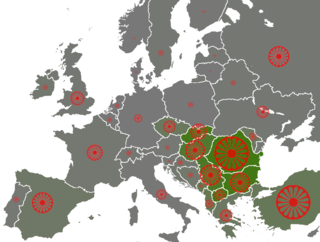Related Research Articles

The Romani, also spelled Romany or Rromani, colloquially known as the Roma, are an Indo-Aryan ethnic group who traditionally lived a nomadic, itinerant lifestyle. Linguistic and genetic evidence suggests that the Romani originated in the Indian subcontinent; in particular, the region of present-day Rajasthan. Their subsequent westward migration, possibly in waves, is now believed by historians to have occurred around 1000 CE. Their original name is from the Sanskrit word डोम (doma) and means a member of a Dalit caste of travelling musicians and dancers. The Roma population moved west into the Persian Ghaznavid Empire and later into the Byzantine Empire. The Roma arrived in Europe around the 13th to 14th century. Although they are dispersed, their most concentrated populations are located in Europe, especially central, eastern, and southern Europe, as well as western Asia.
The Dom are descendants of the Dom with origins in the Indian subcontinent which through ancient migrations are found scattered across Middle East, North Africa, the Eastern Anatolia Region, and parts of the Balkans and Hungary. The traditional language of the Dom is Domari, an endangered Indo-Aryan language, thereby making the Dom an Indo-Aryan ethnic group.

Ian Francis Hancock is a linguist, Romani scholar and political advocate. He was born and raised in England and is one of the main contributors in the field of Romani studies.

The Lom people, also known by non-Loms as Bosha or Posha or as Armenian Romani or Caucasian Romani, are an ethnic group originating from the Indian subcontinent. Their Lomavren language is a mixed language, combining an Indo-Aryan substrate with Armenian.

Romanichals are a Romani subgroup within the United Kingdom and other parts of the English-speaking world. There are an estimated 500,000 Romani in the United Kingdom; almost all live in England. Most Romanichal speak Angloromani, a mixed language that blends Romani vocabulary with English syntax.

Domari is an endangered Indo-Aryan language, spoken by Dom people scattered across the Middle East and North Africa. The language is reported to be spoken as far north as Azerbaijan and as far south as central Sudan, in Turkey, Iran, Iraq, Palestine, Israel, Jordan, Egypt, Sudan, Libya, Tunisia, Algeria, Morocco, Syria and Lebanon. Based on the systematicity of sound changes, it is known with a fair degree of certainty that the names Domari and Romani derive from the Indo-Aryan word ḍom. Although they are both Central Indo-Aryan languages, Domari and Romani do not derive from the same immediate ancestor. The Arabs referred to them as Nawar as they were a nomadic people that originally immigrated to the Middle East from the Indian subcontinent.
The Romani people, also referred to as Roma, Sinti or Kale, depending on the sub-group, are an Indo-Aryan ethnic group which primarily lives in Europe. The Romani may have migrated from what is the modern Indian state of Rajasthan, migrating to the northwest around 250 BCE. Their subsequent westward migration, possibly in waves, is now believed to have occurred beginning in about 500 CE. It has also been suggested that emigration from India may have taken place in the context of the raids by Mahmud of Ghazni. As these soldiers were defeated, they were moved west with their families into the Byzantine Empire.

Human rights in Spain are set out in the 1978 Spanish constitution. Sections 6 and 7 guarantees the right to create and operate political parties and trade unions so long as they respect the Constitution and the law.

The Lyuli, Jughi or Jugi are a branch of the Ghorbati people living in Central Asia, primarily Tajikistan, Uzbekistan, Turkmenistan, Kazakhstan, and southern Kyrgyzstan; also, related groups can be found in Turkey, and the Balkans, Crimea, Southern Russia and Afghanistan. They speak ethnolects of the Persian and Turkic language and practice Sunni Islam. The terms Lyuli and Jugi are considered pejorative. They have a clan organization. Division into sub-clans is also practiced. The Lyuli community is extremely closed towards non-Lyuli.

Anti-Romani sentiment is a form of bigotry which consists of hostility, prejudice, discrimination, racism and xenophobia which is specifically directed at Romani people. Non-Romani itinerant groups in Europe such as the Yenish, Irish and Highland Travellers are frequently given the name "gypsy" and as a result, they are frequently confused with the Romani people. As a result, sentiments which were originally directed at the Romani people are also directed at other traveler groups and they are frequently referred to as "antigypsy" sentiments.

The Romani people have several distinct populations, the largest being the Roma and the Calé, who reached Anatolia and the Balkans in the early 12th century, from a migration out of the Indian subcontinent beginning about 1st century – 2nd century AD. They settled in the areas of present-day Turkey, Greece, Serbia, Romania, Croatia, Moldova, Bulgaria, North Macedonia, Hungary, Albania, Kosovo, Bosnia and Herzegovina, Czech Republic, Slovenia and Slovakia, by order of volume, and Spain. From the Balkans, they migrated throughout Europe and, in the nineteenth and later centuries, to the Americas. The Roma population in the United States is estimated at more than one million.

Romani people in Hungary are Hungarian citizens of Romani descent. According to the 2011 census, they comprise 3.18% of the total population, which alone makes them the largest minority in the country, although various estimations have put the number of Romani people as high as 8% of the total population. They are sometimes referred as Hungarian Gypsies, but that is considered to be a racial slur.
Nawar is an Arabic term for several nomad communities used primarily in Jordan, Syria, Lebanon, and Palestine. The term, regarded as derogatory, is used by Arabs for several diverse ethnic groups. They have historically been called "Gypsies", though as a whole they only have economic activities and lifestyle in connection with the Romani. The Dom people are especially known as Nawar.

The Romani people are also known by a variety of other names; in English as gypsies or gipsies, and Roma; in Greek as γύφτοι (gíftoi) or τσιγγάνοι (tsiggánoi), in Central and Eastern Europe as Tsingani ; in France as gitans besides the dated terms bohémiens and manouches; in Italy as rom and sinti besides the dated terms zingari, sigani, and gitani; in Spain as gitanos; and in Portugal as ciganos.
It is estimated that there are one million Romani people in the United States. Though the Romani population in the United States has largely assimilated into American society, the largest concentrations are in Southern California, the Pacific Northwest, Southwestern United States, Texas, Louisiana, Florida and the Northeast as well as in cities such as Chicago and St. Louis.
Doms in Libya speak the Domari language. They immigrated to the territory of the present day Libya from South Asia, particularly from India, in Byzantine times. people self-segregated themselves for centuries from the dominant culture of Libya. Historically, Gypsies in Libya have provided musical entertainment as weddings and other celebrations. The Dom people in Libya include subgroups like Nawar, Halebi and Ghagar.
Dom people or "Ghagar" migrated during the Roman era to the territory of the present day Egypt from South Asia, particularly from Indian Subcontinent, and heavily intermixed with Egyptians. Scholars suggest that their Egyptian admixture later made them known around the world by the short term Gypsy, a short for Egyptian. Though some of the Dom people self-segregated themselves for centuries from the dominant culture of Egypt, historically; Domari in Egypt have intermixed with Egyptians and participated at local musical entertainment at weddings, boy islamic circumcision and other celebrations, singing Egyptian traditional songs and dance in return for money. The Dom people in Egypt or Roma Egyptians include subgroups like Nawar, and Ghagar (ghaggar). The Dom in Egypt are Sunni Muslims and speak Egyptian Arabic also their own Domari language together.
Romani people in Algeria historically included Gitanos who migrated there along with other Spanish people in the late 19th century, during the French colonial period; most of these left for France following Algeria's independence in 1962, resulting in a large community in the South of France. Ratcliffe (1933) describes a Gitano encampment on the heights above Algiers, whose Catholic inhabitants sold lace and mended chairs. Notable descendants of the Gitanos who used to live in Algeria include the film-maker Tony Gatlif and the footballer André-Pierre Gignac.
Doms in Sudan speak the Domari language. They immigrated to the territory of the present day Sudan from South Asia, particularly from India, in Byzantine times. Dom and Nawar people self-segregated themselves for centuries from the dominant culture of Sudan, who view Romani as dishonorable though clever. Historically, Gypsies in Sudan have provided musical entertainment as weddings and other celebrations. The Romani people or Gypsies in Sudan include subgroups like Nawar, Halebi and Ghagar.
Doms in Tunisia speak the Domari language. They immigrated to the territory of the present day Tunisia from South Asia, particularly from India, in Byzantine times. Dom and Nawar people self-segregated themselves for centuries from the dominant culture of Tunisia, who view Romani as dishonorable though clever. Historically, Gypsies in Tunisia have provided musical entertainment as weddings and other celebrations. The Romani people or Gypsies in Tunisia include subgroups like Nawar, Halebi and Ghagar.
References
- ↑ "The Dom of North Africa: An Overview". Archived from the original on 2020-04-07. Retrieved 2015-08-22.
- ↑ Peoples on the Move: Introducing the Nomads of the World. By David J. Phillips
- ↑ Berland, Joseph C. (2004). Customary Strangers: New Perspectives on Peripatetic Peoples in the Middle East, North Africa, and Asia. Westport, Connecticut: Praeger Publishers. ISBN 0-89789-771-4 . Retrieved 2013-10-28.
- ↑ Dictionary of Gypsy Life and Lore.